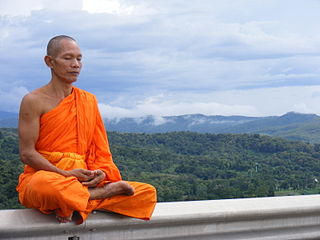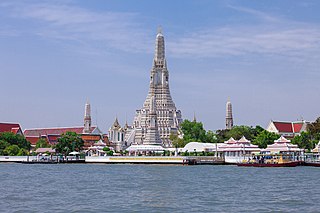
In Buddhism, the Four Noble Truths are "the truths of the Noble Ones", the truths or realities for the "spiritually worthy ones". The truths are:

The Noble Eightfold Path is an early summary of the path of Buddhist practices leading to liberation from samsara, the painful cycle of rebirth, in the form of nirvana.
Rebirth in Buddhism refers to the teaching that the actions of a person lead to a new existence after death, in an endless cycle called saṃsāra. This cycle is considered to be dukkha, unsatisfactory and painful. The cycle stops only if liberation is achieved by insight and the extinguishing of craving. Rebirth is one of the foundational doctrines of Buddhism, along with karma, nirvana and moksha.

In Buddhism, the Seven Factors of Awakening are:

In Buddhism, kammaṭṭhāna is a Pali word which literally means the place of work. Its original meaning was someone's occupation. It has several distinct but related usages, all having to do with Buddhist meditation.
Āyatana is a Buddhist term that has been translated as "sense base", "sense-media" or "sense sphere". In Buddhism, there are six internal sense bases and six external sense bases.
Vijñāna (Sanskrit) or viññāṇa (Pāli) is translated as "consciousness," "life force," "mind," or "discernment."
The brahmavihārās are a series of four Buddhist virtues and the meditation practices made to cultivate them. They are also known as the four immeasurables or four infinite minds. The Brahma-viharas are:
- loving-kindness or benevolence (maitrī/mettā)
- compassion (karuṇā)
- empathetic joy (muditā)
- equanimity (upekṣā/upekkhā)
The Brahmajāla Sutta is the first of 34 suttas in the Dīgha Nikāya. The name means Net of Brahmā. The sutta is also called 'Atthajala', Dhammajala,, Ditthijala, Anuttarasangama Vijaya.
Jarāmaraṇa is Sanskrit and Pāli for "old age" and "death". In Buddhism, jaramarana is associated with the inevitable decay and death-related suffering of all beings prior to their rebirth within saṃsāra.

Buddhist cosmology is the description of the shape and evolution of the Universe according to the Buddhist scriptures and commentaries.
The four stages of enlightenment in Early Buddhism and Theravada are four progressive stages culminating in full enlightenment as an Arahant.
A deva in Buddhism is one of many different types of non-human beings who share the godlike characteristics of being more powerful, longer-lived, and, in general, much happier than humans, although the same level of veneration is not paid to them as to buddhas.
Humans in Buddhism are the subjects of an extensive commentarial literature that examines the nature and qualities of a human life from the point of view of humans' ability to achieve enlightenment. In Buddhism, humans are just one type of sentient being, that is a being with a mindstream. In Sanskrit Manushya means an Animal with a mind. In Sanskrit the word Manusmriti associated with Manushya was used to describe knowledge through memory. The word Muun or Maan means mind. Mind is collection of past experience with an ability of memory or smriti. Mind is considered as an animal with a disease that departs a soul from its universal enlightened infinitesimal behavior to the finite miserable fearful behavior that fluctuates between the state of heaven and hell before it is extinguished back to its infinitesimal behavior.
In Buddhism, a sotāpanna (Pali), śrotāpanna, "stream-enterer", "stream-winner", or "stream-entrant" is a person who has seen the Dharma and consequently, has dropped the first three fetters that bind a being to rebirth, namely self-view (sakkāya-ditthi), clinging to rites and rituals (sīlabbata-parāmāsa), and skeptical indecision (Vicikitsa).
In English translations of Buddhist texts, householder denotes a variety of terms. Most broadly, it refers to any layperson, and most narrowly, to a wealthy and prestigious familial patriarch. In contemporary Buddhist communities, householder is often used synonymously with laity, or non-monastics.
In Buddhism, a mental fetter, chain or bond shackles a sentient being to saṃsāra, the cycle of lives with dukkha. By cutting through all fetters, one attains nibbāna.
In Buddhism, bodhipakkhiyā dhammā are qualities (dhammā) conducive or related to (pakkhiya) awakening (bodhi).

Buddhism is a religion and philosophy encompassing a variety of traditions, beliefs and practices, largely based on teachings attributed to Siddhartha Gautama, commonly known as the Buddha, "the awakened one".
In the oldest texts of Buddhism, dhyāna (Sanskrit) or jhāna (Pāḷi) is the training of the mind, commonly translated as meditation, to withdraw the mind from the automatic responses to sense-impressions, and leading to a "state of perfect equanimity and awareness (upekkhā-sati-parisuddhi)." Dhyāna may have been the core practice of pre-sectarian Buddhism, in combination with several related practices which together lead to perfected mindfulness and detachment, and are fully realized with the practice of dhyana.





